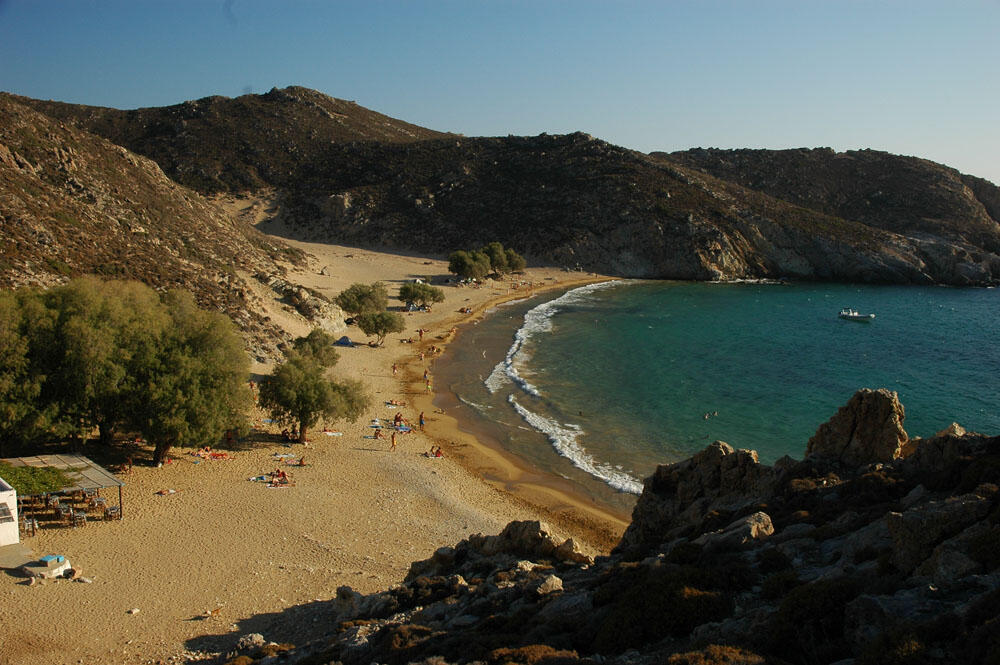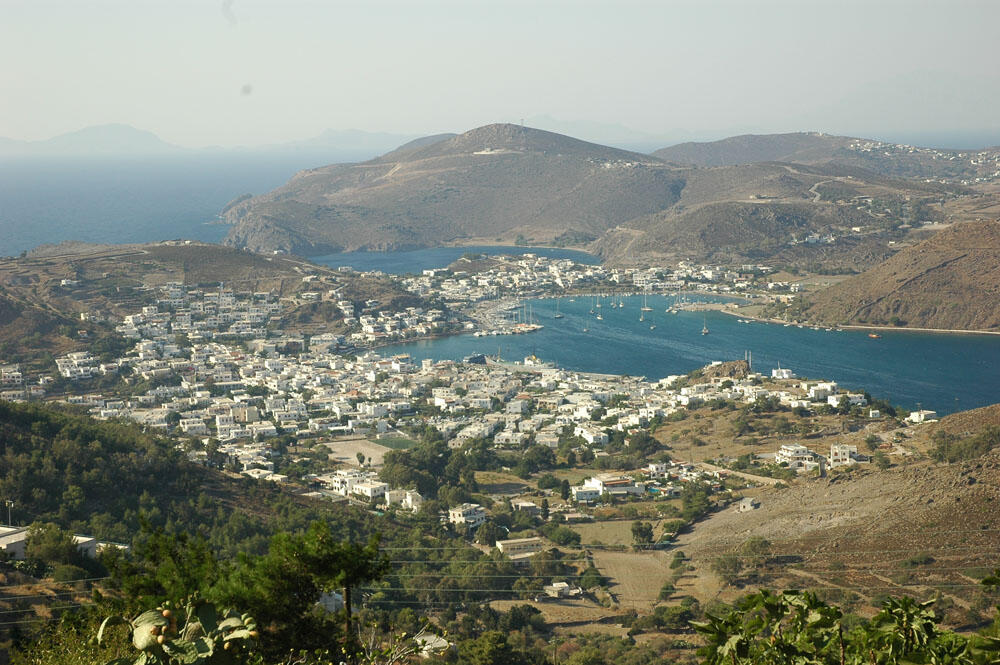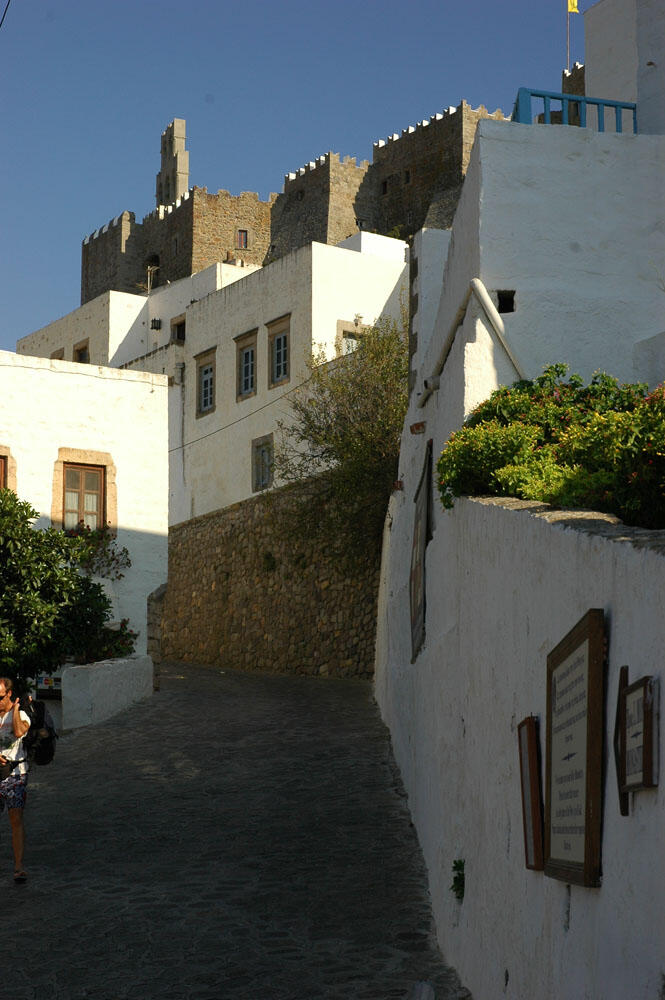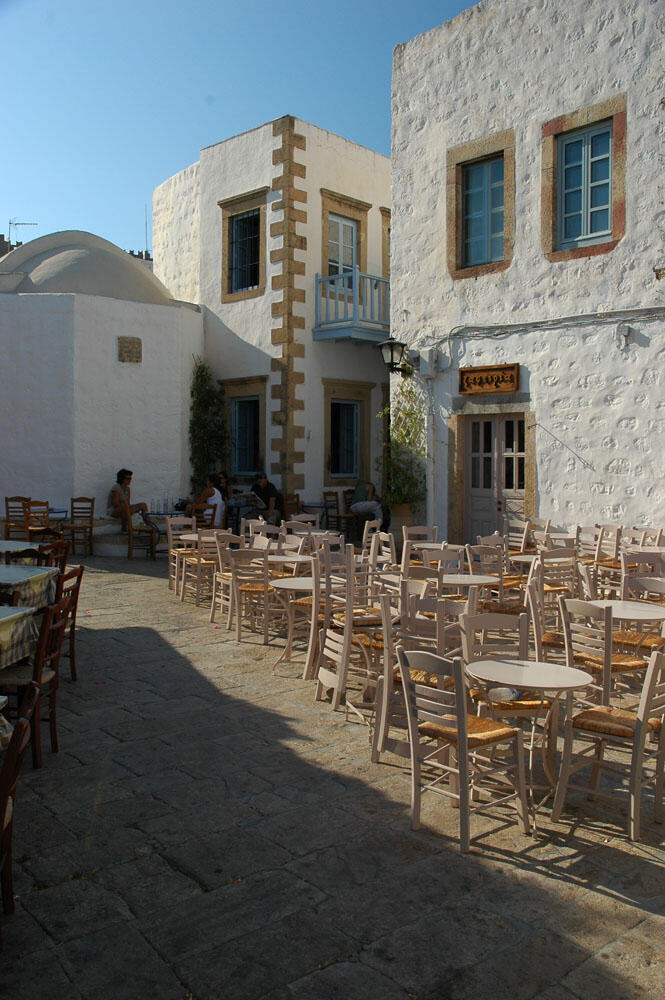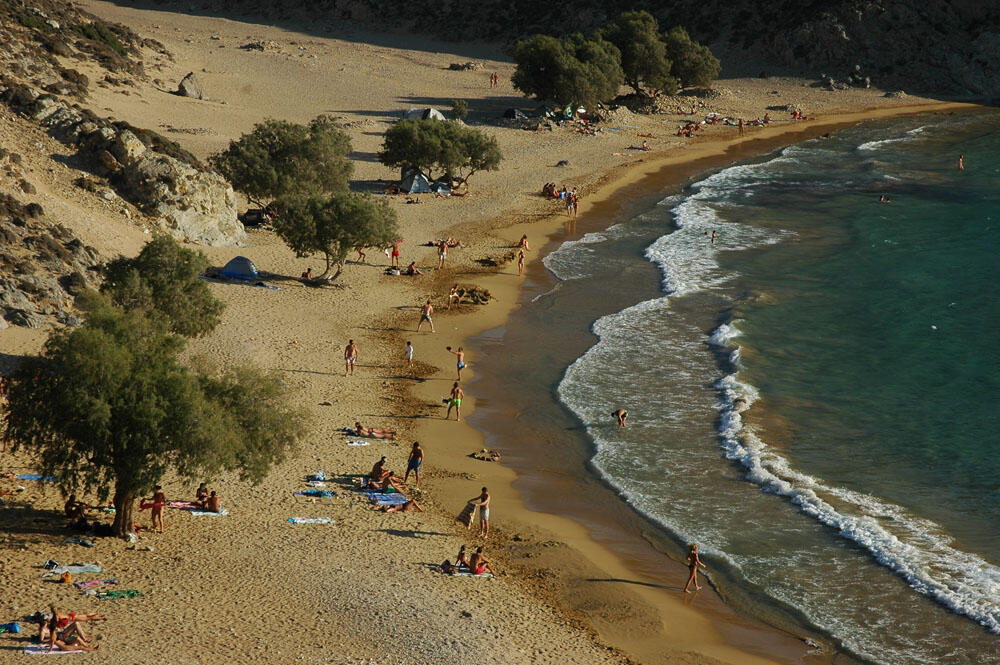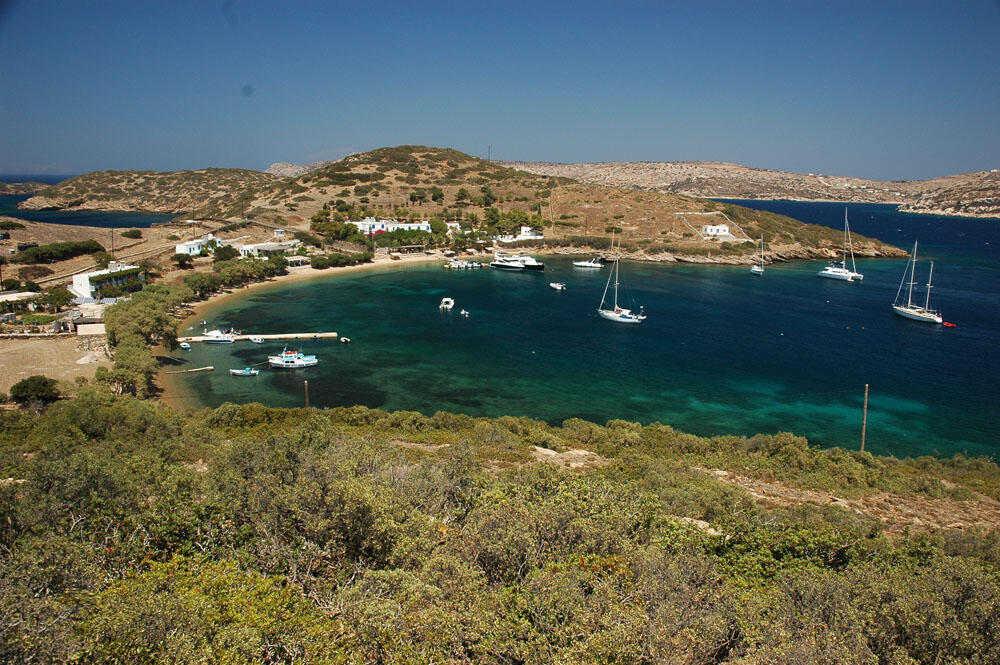
Marathi island
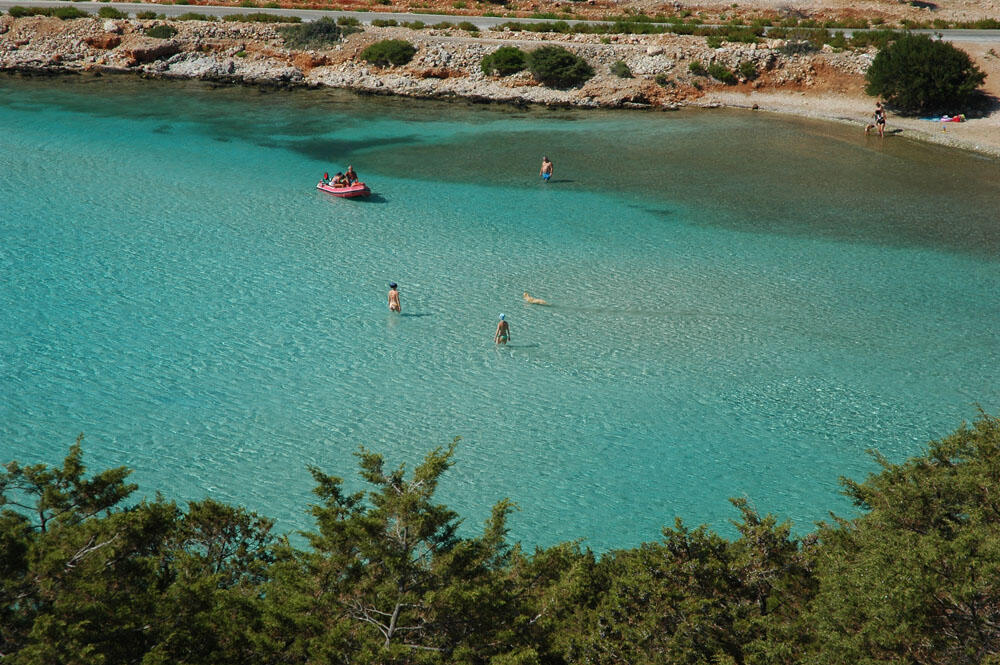
Lipsi Island

Marathi island

Lipsi Island
Patmos Island
The next morning, we set sail to the sacred island of the Aegean, Patmos, just nine miles to the west. The island of the Revelation, as it is also called, is undoubtedly one of the prettiest and most distinct islands of our country.
Apart from the intense division of its coastlines and the countless coves, what really makes it special is the imposing fortified monastery and the white houses of the Chora that surround it, offering a breathtaking sight from miles away. The almost permanent, strong and staccato ripple in the narrow passage between Arki and Patmos, and the large amounts of sea spray that drenched us as the winds were on our side, managed to soak us after a while.
Entering Skala, the port of Patmos which is located in the middle of the east side of the island, we headed to the waterfront where the sailboats and the large ships moor. While we were waiting for the small fuel van, we got ice supplies, since the ice-making store is just on the opposite side of the street. In a little while we were anchored to the wooden docks on the northern side of the harbour, which is the quietest place. The harbour of Patmos called Skala is one of the safest in the Aegean, penetrating deep into the land and this looks as if it is trying to split the island in two. It is a busy harbour, with all sorts of ships entering and sailing at any time, often causing congestion. We took the road that unfolds around the harbour and walked to the south side. There is the central square which is the starting point of the streets leading to the inner part of Skala. Here is the focal point of the island’s “life”. Shops in a row, taverns, cafes, street vendors spread their merchandise in stalls and large crowds go by in the alleys. For some time we scattered in the narrow streets, looking around and buying some souvenirs.
In the castle area
At midday we took the bus leaving every hour on the hour from the port, and in ten minutes we were on the top of the hill, where the dreamlike Chora is found. There are amazing houses of unique architecture, resembling strongly to fortified buildings to provide the necessary protection from pirate raids in the past. Moving to the central stone paved street, we stopped at every corner to admire the unique mansions with the elaborate architectural details. Magnificent, attached houses with pebbled courtyards and colourful flowers create a protective wall, which along with the numerous alleys and small porticos, constitute one of the oldest settlements in our country, proclaimed as a World Heritage Site by UNESCO. Through the village of the Chora with its whitewashed houses, most of which have been sold to foreigners, emerge the impressive tall grey walls of the Monastery of Ag. Ioannis, creating one of the most beautiful images that we have ever seen. If we turn towards the sea, the view of the Scala and the northern coasts of Patmos is magnificent. Wherever you stand, no matter which place you choose to look around, the view is spectacular.
We kept walking on the central alley and we went to the small square of Agia Lesbia, one of the most picturesque places of the Chora. A cafe, an ouzo bar and a tavern spread their wooden tables on the small stone square, which perched among the whitewashed walls of the houses, looks like a fairy neighbourhood, a masterpiece of beauty and aesthetics. At that time the small square was empty. We sat for a while in the ouzo bar in the corner and enjoyed the magnificent landscape around us. When it starts getting dark the setting changes. The square has a lively atmosphere by the voices and bustle of the people, who crowd in the small place to find a table.
In the cave of the Apocalypse
Having wandered for several hours through the mazy alleys of the Chora, we were as excited as when we visited the place for the first time and we went downhill to the Cave of the Apocalypse. Somewhere halfway between Skala and the Chora, is the sacred Cave where Saint John saw the vision of the Apocalypse. Climbing down several steps, we arrived at the entrance of the church of Ag. Anna. In the temple and on the right side, there is the Holy Cave. On the low roof there is the triple slit, symbol of the Holy Trinity, where John heard the words of God. It is said that in a small recess in the rock the beloved disciple of Christ lay his head to rest, while another one served as a support to help him stand up. This small cave, in which the Revelation was born, attracts many visitors from all over the world.
We kept going down to the old cobbled road and in a few minutes we were in the port. However, it was late and we needed to find a quieter place to spend the night on the rib. At the same time, we wanted to go out for the night at a seaside tavern.
We had two choices, and they were just three miles south of Skala. So, we quickly untied before dark, and we soon passed by the cape of Chesmeni. Although it was a windless night, in the few square metres around the cape the sea was white with waves and the small ripple was quite forceful, which revealed the origin of this cape’s name. From that point to the south, there is a large bay in the middle of which lies the islet Tragonisi. At the northern side of the bay, the cove Groikos is formed while on the south side there is the creek of Diakofto. Both spots are calm and very good for overnight stay on the boat, far from the noise and bustle.
In Grikos and Diakofti
Grikos is a small and quiet village in the bay that shares the same name, with a nice beach full of sea trees, next to the village. A restaurant and a very nice tavern on the sand are just steps away from the three small piers, where the yachts and fishing boats of the locals harbour. It serves as a suitable base for our wanderings on the southern shores of Patmos, while there is a bus to take us to Chora or Scala.
Diakofti is a more secluded, almost flat place. It is just three hundred metres wide, so it is the narrowest point of the island. Here is where the Kamitsi brothers have their shipyard for new boats and repairs of marine engines.
Inside the shipyard, there is a restaurant with strong marine features, whose owners made it with great care. Portholes, tables with nautical steering wheels, old anchors and an old boat whose deck was similarly transformed as an extension of the restaurant are some of the special features of this wonderful place. The pleasant surprise of course, was the excellent cuisine and amazing food, made with love and based on traditional recipes of Patmos. We stayed here, spending a wonderful evening, tying the boat on the side of the wooden pier of the shipyard.
Sailing south, we passed by the cape Vitsilia, which is the southeastern cape of the island. From that point up to the small Prasonisi an open bay is formed that can be a good shelter from the north winds.
Here, beneath the reddish cliffs, are the beautiful pebbled beaches called Atherina and Ammoudes, secluded and remote, where we can enjoy the absolute serenity of the wild landscape. The large bay of Stavros stretches a mile above. On the east side of its opening, we find the most beautiful beach on the island.
In the renowned Psili Ammos
It is the amazing coast Psili Ammos which though often attacked by the faint mistral waves, attracts many people who arrive, mostly by boats that sail from Skala. The fine golden sand, the green waters, the small tavern at the northern side next to an islet of huge sea trees, and some smaller along the coast, compose a paradise on earth for visitors. If we are looking for more privacy, we only need to move farther into the bay of Stavros, where there are beautiful beaches mainly on the north side.
After spending the whole day on the southern coasts of the island, at dusk we returned to the harbour of Grikos to spend the night. The next day we decided to go to the area which is located above the port of Patmos, and stretches like a big bosom to the cape of Geranos, where there are many bays in a row hosting numerous beaches. They are called Aspri, Meloi, Agriolivado the beach of Kampos which is one of the most popular on the island, Vagia and Ligginos, Livadi of Geranos and they are the main ones. Others, more or less crowded, covered with pebbles or sand, are all protected against the north winds, and in many of them there are taverns on the beach with tasty food. We only have to choose our favourite and anchor. However, we need to pay special attention on the reefs that are scattered across the sea from the island of Ag. Georgios to the cape of Geranos.
For travellers
The amazing fortified monastery of Ag. Ioannis Theologos, which is surrounded by the white cubic houses of the Chora, which are of unique architecture, compose one of the most magical images in the Aegean. As guardians of the archipelago and of the island, against the invaders and the pirates in the past, and against the modern trends that distort everything today, they stand there, intact by the time that goes by and they constitute a “Site” of the World Heritage.
Patmos is a unique travel destination combining the intensely indented coastline of the island and the large number of beaches.
There are vans on the waterfront of the north side of the harbor, where the big boats anchor carrying constantly fuel and water. Just opposite, there is the ice making store and two grocery stores that provide us supplies easily and quickly.
...keep Ribbing!

